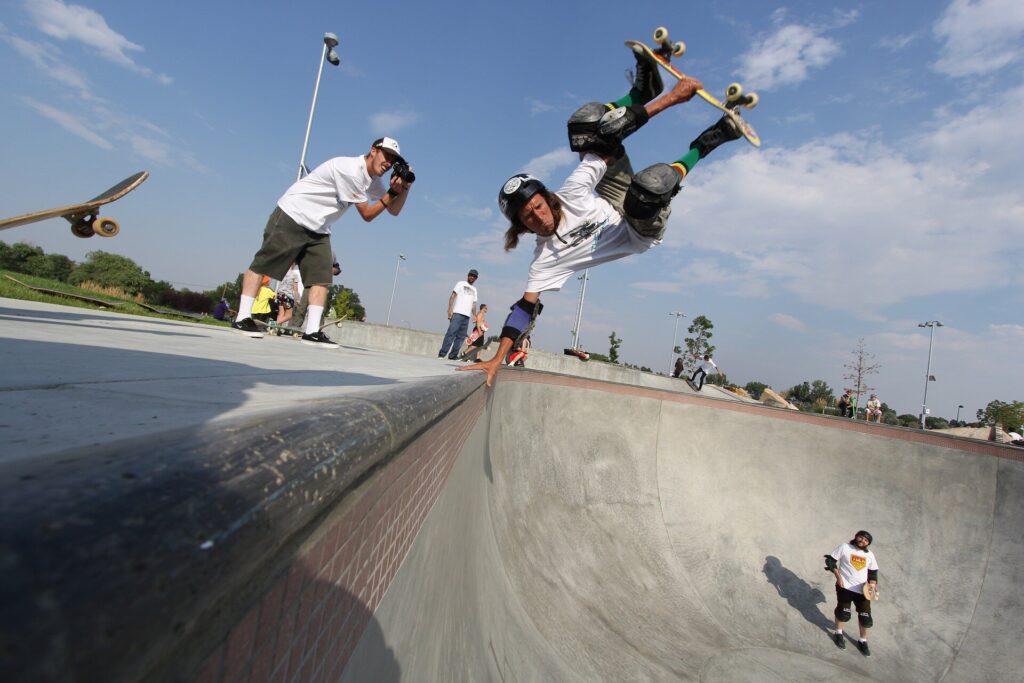[ad_1]

To curb the risk of falls, it may be worth grading skateboard parks like ski runs according to the popularity of the metal and concrete features they contain and the level of expertise required, conclude researchers in the journal Injury Prevention.
Their analysis of the moves performed by more than 500 young skateboarders reveals that flips, jumps, and turns on flat ground and quarterpipe (a curved concave ramp) and ramp tricks seem to pose the greatest risk, and are universally popular.
A grind box, where the T-shaped turn parts under the skateboard deck, known as trucks, slide along the edge or surface of a long relatively narrow box, was also a high-risk feature, but more often used by older skateboarders, the analysis shows.
In recent years, the number of skateparks has increased as the popularity of the sport has grown among young people, note the researchers. While falls are a recognized hazard of the activity, not much is known about the design features of skateparks or the types of tricks performed there that might increase injury risk.
To try and plug this knowledge gap, the researchers set out to identify the preferred features and tricks, and to gauge the frequency and severity of falls, among 526 predominantly male (98%) skateboarders at one large skatepark in Canada.
The skateboarders were divided into a younger group of 11–15-year-olds (166) and an older group of 16–20-year-olds (360) and were unobtrusively video recorded while performing their tricks.
Fall severity was scored whenever a trick was attempted, ranging from 1, indicating successful completion, to 5 and 6, indicating that the skateboarder fell onto part of, or their entire, body.
The proportion of children using each feature was computed for each age group, as was the proportion of falls on each feature. Popular features were defined by at least 10 children in one of the age groups using them.
Among young skateboarders, most (74%) used the flat ground, followed by the quarterpipe (46%) and the ramp (47%). Few attempted the grind box, stairs, or railing.
Older skateboarders spent the most time on the flat ground (71%), the quarterpipe (46%), the ramp (51%), and the grind box (35%). Few used the railing or the stairs.
The highest fall frequency was on the grind box (85% of younger skateboarders; 67% of older ones), followed by the flat ground (65% and 61%, respectively). Lower fall frequency (about 35%) was comparable across both age groups for the quarterpipe and the ramp.
Younger skateboarders experienced the highest risk on the flat ground, followed by the ramp, and the quarter pipe. Older skateboarders also experienced the highest risk on the flat ground, followed by the grind box and the ramp. Fall risk is high on flat ground because it’s used to try out tricks, explain the researchers.
As to the type of preferred tricks, younger skateboarders most often performed turns (61% of them), with jumps, slides, and flips performed less often. They seldom tried other types of tricks.
Older skateboarders mostly did jumps (61% of them) and other types of tricks (53%). Other popular tricks included slides (47%), turns (42%), and stalls (30%).
The highest fall frequency for younger skateboarders was during flips, with 94% of them falling when they tried these, followed by slides (67% fell), and jumps (42%). The highest fall frequency for older skateboarders was also for flips (81% fell) and slides (72%).
There are no universal safety standards for skatepark design, note the researchers, who suggest that features might be grouped together strategically to encourage younger skateboarders in one area and older skateboarders in another.
“Segregating ages by design might reduce imitation of risky tricks performed by older skateboarders that are viewed by younger skateboarders but are beyond their skillset,” they suggest.
“It may prove useful to moderate risk of falling if features are differentially coded across the skatepark to suggest difficulty levels, much like what is done on ski hills,” they add.
Finding ways to encourage skateboarders to use protective gear might also be helpful, given that most of those who featured in the analysis weren’t wearing helmets, for example.
The researchers acknowledge that there were few female skateboarders in their study, and that they graded fall severity on the potential to cause injury.
“It would be useful to talk directly with skateboarders who have experienced a medically attended injury and assess how these affect their decisions with regard to features they will use and/or tricks they plan to attempt on returning to the skatepark,” they conclude.
More information:
Adolescents at the skatepark: identifying design features and youth behaviours that pose risk for falls, Injury Prevention (2023). DOI: 10.1136/ip-2023-045017
Citation:
Grade difficulty of skatepark features like ski runs to curb fall risk, say researchers (2023, December 12)
retrieved 12 December 2023
from https://medicalxpress.com/news/2023-12-grade-difficulty-skatepark-features-curb.html
This document is subject to copyright. Apart from any fair dealing for the purpose of private study or research, no
part may be reproduced without the written permission. The content is provided for information purposes only.
[ad_2]
Source link


